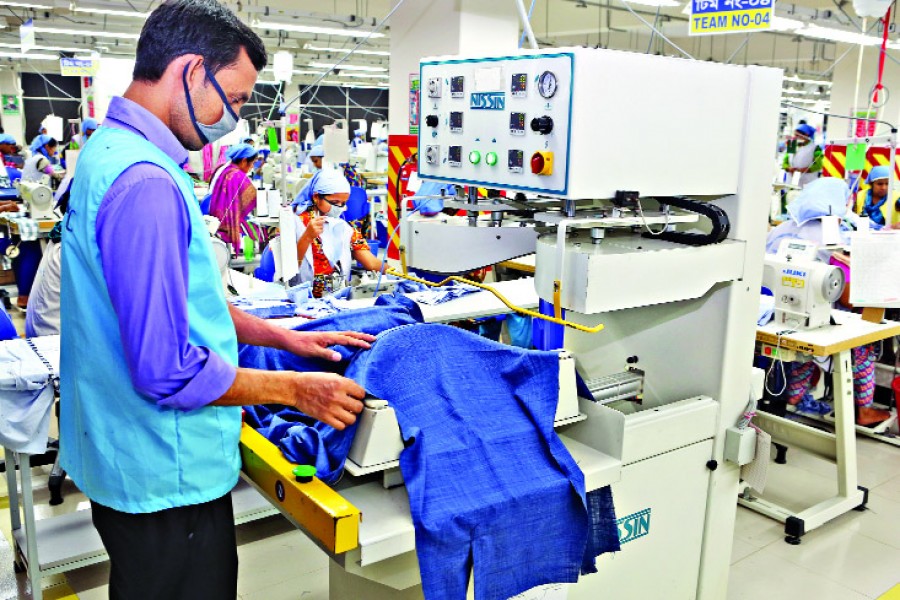
Published :
Updated :

More often than not, cheap labour was believed to fetch competitiveness, especially in manufacturing not-so-upscale products for exports. However, these days, gone is this perception that low labour cost can guarantee competitiveness. For a country like Bangladesh which for the past decades has been thriving primarily because of low wage, time is ripe to part with the low wage-driven approach to stay competitive in the days ahead. The draft of the country's Second Perspective Plan (2021-2041) prepared by the Planning Commission projects this impression in the strongest of words, "In the unfolding industrial universe of the future, Bangladesh firms will face stark reality that competitive advantage founded on low labour cost cannot be guaranteed for all time." The report also said local companies will have to focus on innovation to maintain a competitive edge instead of relying on traditional advantages that have paid off so far. "Without such efforts, entrepreneurs need to be warned that the current competitive advantage in labour-intensive garment exports could be lost in (the) future," the draft report warned.
Developing skills is an open-ended issue. Although it's initially the job market at home and abroad that comes to mind, the idea of skill development is integral to the making of efficient human resource that besides taking care of itself can contribute to the economy in myriad forms and shapes. It is here that skill is essentially a matter of developing the population, preferably youths, in various areas of activities. While higher skill is a matter related to the educated groups, less educated groups are the potential target for hands-on skill development.
The key issue is about developing a national culture for nurturing and developing skills that can only turn humans into resources. This is because, as yet, there is no known or lately innovated shortcut to skill development. Being a continuous process, it calls for persistent and comprehensive planning. Stray efforts in the name of skill development do not pay in the long run. Examples are aplenty of development programmes and industrial productivity languishing in deficiencies mostly from lack of sufficient skills on the part of the manpower engaged at various tiers. As a result, we are yet to see any noticeable improvement in meeting the prevailing skill-gaps in various spheres of productivity. There has not been any stocktaking of quantifiable achievements from various programmes undertaken by the public and private sector, so far.
While deficiencies in skilled human resource at home is made up by large intake of foreigners in various productive sectors, export of unskilled workers abroad is destined to fetch very little in wages and salaries. In both cases, it is the lack of value addition that ultimately costs the country heavily.
It has been found that the country's garment sector alone hires the services of thousands of expat personnel to supervise the day-to-day running of factories. Most of the jobs, as reports say, are not at all high-tech, but require thorough knowledge about machinery and equipment. According to reports the country spends about $5.0 billion a year on overseas employees. On the other hand, Bangladeshi workers in foreign lands are mostly engaged in the low-end wage bracket for want of required skills that otherwise could have fetched them considerably higher incomes, accompanied with other perks such as job security, medical and health insurance facilities.
Although there is no arguing that skilled manpower can cater for the needs at home and abroad, attention should be focused on sector-specific needs. One can hope to see this achieved only if skill development figures as integral to government policies. To start with, there has to be a thrust on vocational learning which, unfortunately is down the drains under the weight of undirected (if not misdirected) education system of the country. There is thus a strong need for advocacy programmes to attract more and more youths to institutes where their learning will pay them gainfully in seeking jobs as well as in running independent production units or businesses as the case may be. In doing so, there is the critical need to have these vocational and technical institutes under the scanner to examine their capacities and resources in providing skills training. Chances are high that many of them will be found in a dire need of resources in terms of technology and manpower to steer skill-building in the right direction.
One of the important issues that must not be lost sight of is that given its demographic advantage at the moment, Bangladesh is better suited than most other countries to reap the benefit of having a large pool of skilled population. Currently, around 76 per cent of our population is within the working age bracket while around 2.1 million people are being added to the workforce each year. Such an increase in workforce gives us a significant leverage in terms of demographic dividend while also allowing us to export additional human resources across the world.
There is thus no alternative to ramping up investment in education for skill development. Thus, youths pursuing higher studies in universities need the academia to thoroughly embrace skill development as integral to the learning process. Unfortunately, most public universities, let alone the private ones, barely have funds to conduct even basic research.
The government has to take note of the deficiencies, both structural and organisational, as well as the current and future needs of the country in various fields where skill can play a predominant role in productivity, stardardisation and service delivery. The onus is entirely on the government to put things in place -- progressively and in a well planned manner.


 For all latest news, follow The Financial Express Google News channel.
For all latest news, follow The Financial Express Google News channel.